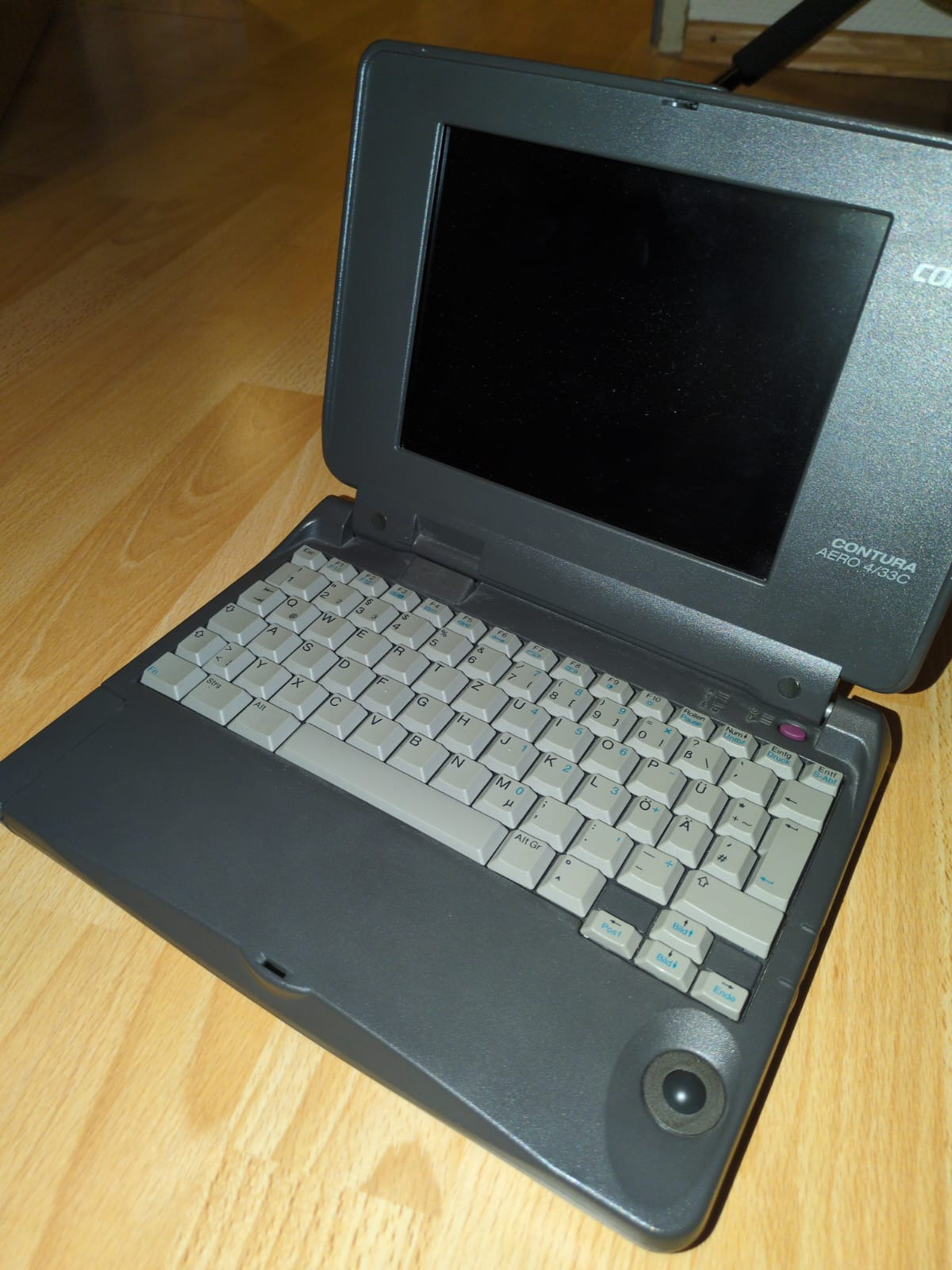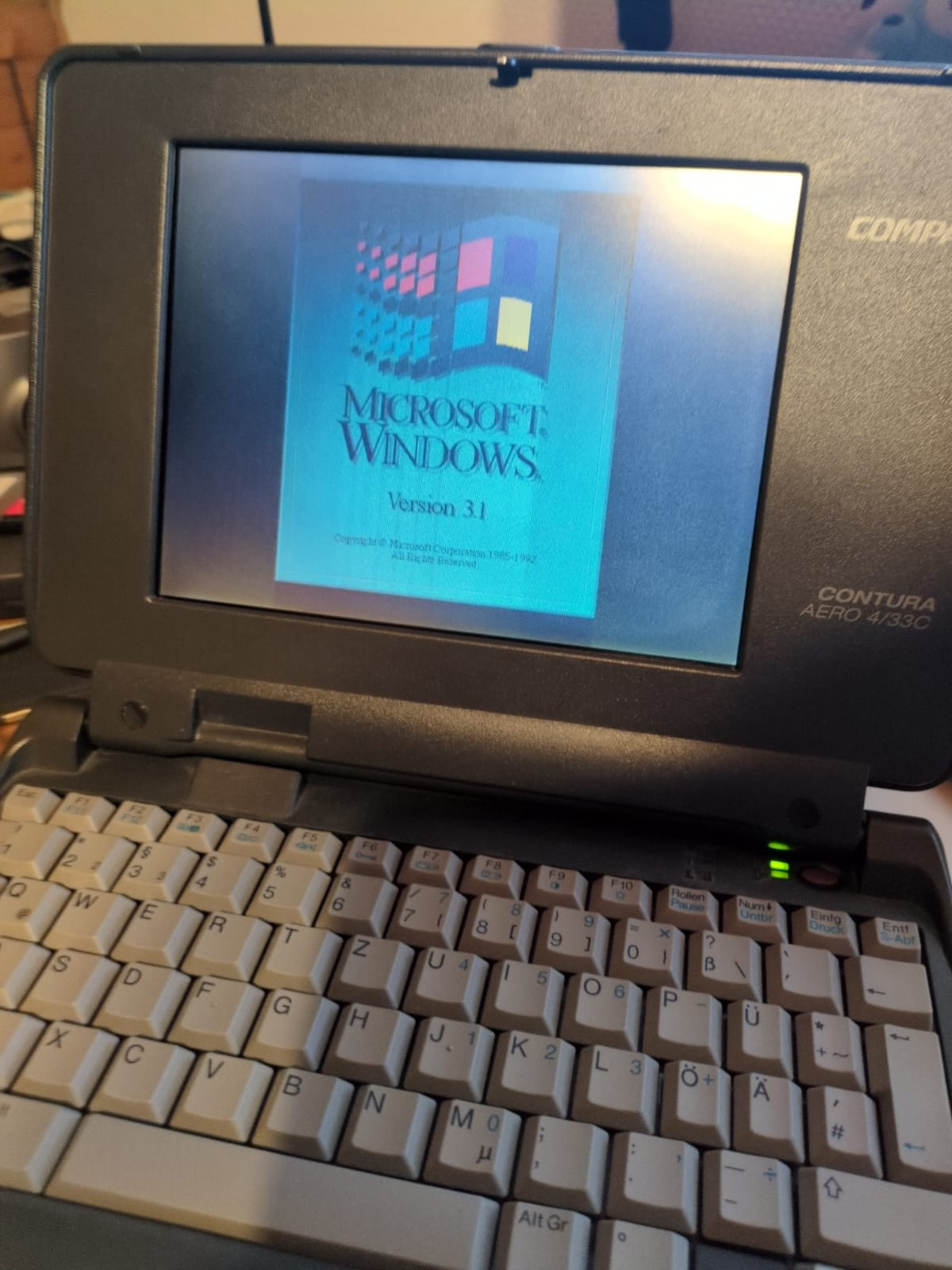The Aero
The Contura Aero is a very special laptop to me. It was the first computer I did not have to share. I was no longer afraid of deleting my father’s work (or being blamed for it).
It was a gift from another person. It was a quite an expensive and luxurious computer for Chile in 1994 when I got it. My family would not have bought one just for me. I am grateful for it since it supported my interest for computers for many years.
For some years I became nostalgic about it and wanted to experience it again.

The restoration
The Aero has a design problem in the display clutch (see 2.1.5.7 Screen hinge problem (the darn “clutch”) in the FAQ) which makes very hard to find one without a broken display bezel.
Over the span of a few years I bought two units on eBay. The first one had the broken bezel. I bought a second unit, without the cracks but it had a display that turned on and off intermittently. The plan was to make one out of two or three units.
Luckily, in addition to the FAQ, there are different “cult” sites like https://remember.the-aero.org/ where one can find all kind of information.
Opening the device requires patience and being careful.
CMOS battery
When I replaced the CMOS battery, the battery holder broke, and I had to unsolder the one from the other motherboard and pray it worked. It did.


Storage
Another question was whether to replace the hard disk. They are noisy, but the current one had a working Windows 95 install.
I thought about replacing it with a 32GB M.2 SATA SSD on top of a 2.5“ IDE adapter.
It did not boot.
I spent a lot of time here. I thought I could do all the installations on a VM putting the SSD on a M.2 SATA to USB adapter and have libvirt access the device directly.
I had not enabled LBA on the BIOS, which required an update first and then to select hard disk as “Other” type. Also I forgot the IDE adapter and the USB adapter could be exposing different geometries when I did the partition on the VM
After updating the BIOS, changing the hard disk type and using a BIOS overlay driver (Ontrack Disk Manager), which nowadays you can get for free, and installing DOS directly from floppies, I had a bootable machine with several logical drive letters (C:, D:, E:, F:…) of 2G each.
Before closing it, I wanted to put as much software on the drive to play later, as I did not have another good way of moving data.
Unfortunately, the partition type Ontrack Disk Manager creates is not a standard partition, but I could mount it by creating a loop device from the offset and then
losetup --partscan --find --show -o 32256 /dev/sdb
And then you could see all FAT partitions using the loop device:
fdisk /dev/loop0 -l
mount /dev/loop0p1 /mnt/c
I put it different Windows I had on CDs, and a full copy of the MS-DOS SIMTEL Collection, which I owned and offered in my BBS around 1995.
Closing
When I was ready to close it and put back the screen bezel (the good one, the other was broken) I realized, the good one was missing a piece of plastic which allows the bezel screw to fixate against the display.

Instead of the screw cup, there was a hole:

I had to fix this. Or choose to live with the broken Bezel which had a visible crack.
My wife suggested I 3D print it. I initially dismissed the idea because I don’t have any 3D modeling skills, but it resulted much easier than I thought.
There is a CAD program you can use with code, which is quite simple for these geometrical stuff. Especially if you start with some AI prompt and iterate from there.

8 prototypes later and 2-3 min of print time each, I had the one I thought it would work.
Surprisingly, it worked perfectly, I did not even feel forcing the screw. And it closed.

Final result



Future improvements
Battery
I have no idea if it works and it looks like the previous owner already opened the enclosure to change the cells.
RAM
I will try to get the 8M module to get 16M instead of the 12 (4+8) it has right now.
Connectivity
Find some PCMCIA card with Ethernet and combine it with some WIFI access point and get it online somehow on MS-DOS.
Next projects
- My previous computer to this one, a rare taiwanese CAF 386SX which I was looking for years and finally found and acquired.
- An Atari 130XE, which I disassembled and applied the process to get rid of the yellow color, but never assembled back.
- My Timex Sinclair rescued from my parents (in perfect condition). Need to figure the TV/display part.